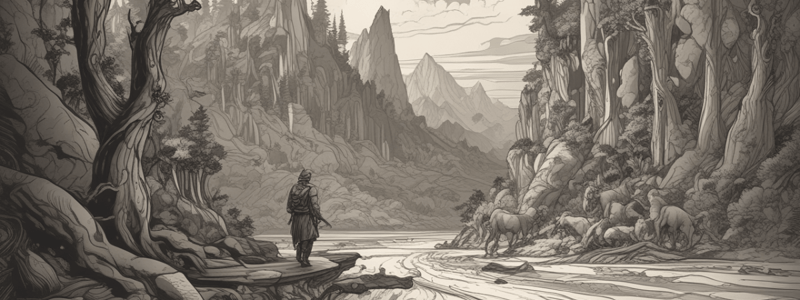Podcast
Questions and Answers
What is the main purpose of descriptive writing?
What is the main purpose of descriptive writing?
- To summarize a long passage into a shorter form
- To create a vivid picture in the reader's mind (correct)
- To provide facts and information about a topic
- To persuade the reader to a particular point of view
What type of details are often used in descriptive writing?
What type of details are often used in descriptive writing?
- Historical dates and events
- Facts and statistics
- Opinions and biases
- Sensory details, such as sights and sounds (correct)
What makes the second sentence more interesting than the first?
What makes the second sentence more interesting than the first?
- It uses more complex vocabulary
- It creates a vivid picture in the reader's mind (correct)
- It has more words
- It has a question mark at the end
When writing a descriptive paragraph or essay, what should you do first?
When writing a descriptive paragraph or essay, what should you do first?
What is the effect of descriptive writing on the reader?
What is the effect of descriptive writing on the reader?
What is the main purpose of including sensory details in a descriptive writing?
What is the main purpose of including sensory details in a descriptive writing?
What should you do after selecting a topic to write about?
What should you do after selecting a topic to write about?
Why is it important to revise your descriptive paragraph or essay?
Why is it important to revise your descriptive paragraph or essay?
What should you ask yourself when revising your descriptive writing?
What should you ask yourself when revising your descriptive writing?
What is the result of including sensory details in a descriptive writing?
What is the result of including sensory details in a descriptive writing?
Flashcards are hidden until you start studying
Study Notes
Descriptive Writing
- Descriptive writing uses carefully selected words to create a vivid picture in the reader's mind, focusing on sensory details like sights, sounds, smells, tastes, and feelings.
- The goal is to make readers feel like they are experiencing what the author is describing.
Key Features of Descriptive Writing
- Uses sensory details to create a mental image
- Involves using words that appeal to the senses (e.g., 'cheering crowd', 'metallic gray sunglasses', 'glittering lights')
- Helps readers imagine and relate to the topic being described
Writing a Descriptive Paragraph
- Use your senses to describe a topic
- Ask yourself questions to identify sensory details (e.g., what do I see, hear, smell, taste, feel?)
- Use descriptive language to bring the topic to life
Revising a Descriptive Paragraph
- Revise to ensure the topic is described in ways beyond just its appearance
- Consider comparing the topic to something familiar to the reader
- Check if the writing helps the reader experience and relate to the topic
Studying That Suits You
Use AI to generate personalized quizzes and flashcards to suit your learning preferences.




